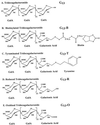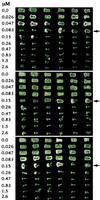Biological activity of reducing-end-derivatized oligogalacturonides in tobacco tissue cultures
- PMID: 9536045
- PMCID: PMC35035
- DOI: 10.1104/pp.116.4.1289
Biological activity of reducing-end-derivatized oligogalacturonides in tobacco tissue cultures
Abstract
The biological activity of reducing-end-modified oligogalacturonides was quantified in four tobacco (Nicotiana tabacum) tissue culture bioassays. The derivatives used were oligogalacturonides with the C-1 of their reducing end (a) covalently linked to a biotin hydrazide, (b) covalently linked to tyramine, (c) chemically reduced to a primary alcohol, or (d) enzymatically oxidized to a carboxylic acid. These derivatives were tested for their ability to (a) alter morphogenesis of N. tabacum cv Samsun thin cell-layer explants, (b) elicit extracellular alkalinization by suspension-cultured cv Samsun cells, (c) elicit extracellular alkalinization by suspension-cultured N. tabacum cv Xanthi cells, and (d) elicit H2O2 accumulation in the cv Xanthi cells. In all four bioassays, each of the derivatives had reduced biological activity compared with the corresponding underivatized oligogalacturonides, demonstrating that the reducing end is a key element for the recognition of oligogalacturonides in these systems. However, the degree of reduction in biological activity depends on the tissue culture system used and on the nature of the specific reducing-end modification. These results suggest that oligogalacturonides are perceived differently in each tissue culture system.
Figures








Similar articles
-
Linear beta-1,3 glucans are elicitors of defense responses in tobacco.Plant Physiol. 2000 Nov;124(3):1027-38. doi: 10.1104/pp.124.3.1027. Plant Physiol. 2000. PMID: 11080280 Free PMC article.
-
A method for biotin labeling of biologically active oligogalacturonides using a chemically stable hydrazide linkage.Anal Biochem. 1997 Jun 15;249(1):10-9. doi: 10.1006/abio.1997.2165. Anal Biochem. 1997. PMID: 9193702
-
Synthesis and characterization of tyramine-derivatized (1-->4)-linked alpha-D-oligogalacturonides.Carbohydr Res. 1996 Sep 2;290(2):147-57. doi: 10.1016/0008-6215(96)00075-4. Carbohydr Res. 1996. PMID: 8823904
-
Identification of calreticulin-like protein as one of the phosphoproteins modulated in response to oligogalacturonides in tobacco cells.Planta. 1997;202(3):341-8. doi: 10.1007/s004250050136. Planta. 1997. PMID: 9232905
-
Polygalacturonase, PGIP and oligogalacturonides in cell-cell communication.Biochem Soc Trans. 1994 May;22(2):394-7. doi: 10.1042/bst0220394. Biochem Soc Trans. 1994. PMID: 7958332 Review. No abstract available.
Cited by
-
Suramin inhibits initiation of defense signaling by systemin, chitosan, and a beta-glucan elicitor in suspension-cultured Lycopersicon peruvianum cells.Proc Natl Acad Sci U S A. 2000 Aug 1;97(16):8862-7. doi: 10.1073/pnas.97.16.8862. Proc Natl Acad Sci U S A. 2000. PMID: 10922047 Free PMC article.
-
The intracellular and intercellular cross-talk during subsidiary cell formation in Zea mays: existing and novel components orchestrating cell polarization and asymmetric division.Ann Bot. 2018 Nov 3;122(5):679-696. doi: 10.1093/aob/mcx193. Ann Bot. 2018. PMID: 29346521 Free PMC article. Review.
-
A census of carbohydrate-active enzymes in the genome of Arabidopsis thaliana.Plant Mol Biol. 2001 Sep;47(1-2):55-72. Plant Mol Biol. 2001. PMID: 11554480
-
The potential physiological implications of polygalacturonic acid-mediated production of superoxide.Plant Signal Behav. 2010 Dec;5(12):1525-9. doi: 10.4161/psb.5.12.12838. Epub 2010 Dec 1. Plant Signal Behav. 2010. PMID: 21139441 Free PMC article.
-
Growth and anatomical parameters of adventitious roots formed on mung bean hypocotyls are correlated with galactoglucomannan oligosaccharides structure.ScientificWorldJournal. 2012;2012:797815. doi: 10.1100/2012/797815. Epub 2012 May 22. ScientificWorldJournal. 2012. PMID: 22666154 Free PMC article.
References
-
- Basse CW, Fath A, Boller T. High affinity binding of a glycopeptide elicitor to tomato cells and microsomal membranes and displacement by specific glycan suppressors. J Biol Chem. 1993;268:14724–14731. - PubMed
-
- Baureithel K, Felix G, Boller T. Specific, high affinity binding of chitin fragments to tomato cells and membranes. Competitive inhibition of binding by derivatives of chitin fragments and a nod factor of Rhizobium. J Biol Chem. 1994;269:17931–17938. - PubMed
-
- Bellincampi D, Salvi G, De Lorenzo G, Cervone F, Marfà V, Eberhard S, Darvill A, Albersheim P. Oligogalacturonides inhibit the formation of roots on tobacco explants. Plant J. 1993;4:207–213.
-
- Bishop PD, Pearce G, Bryant JE, Ryan CA. Isolation and characterization of the proteinase inhibitor-inducing factor from tomato leaves. Identity and activity of poly- and oligogalacturonide fragments. J Biol Chem. 1984;259:13172–13177. - PubMed
Publication types
MeSH terms
Substances
LinkOut - more resources
Full Text Sources

